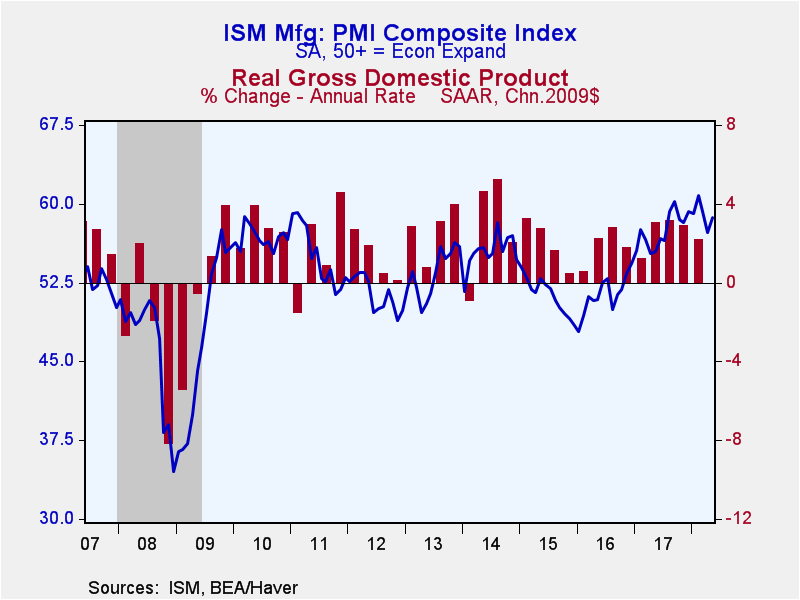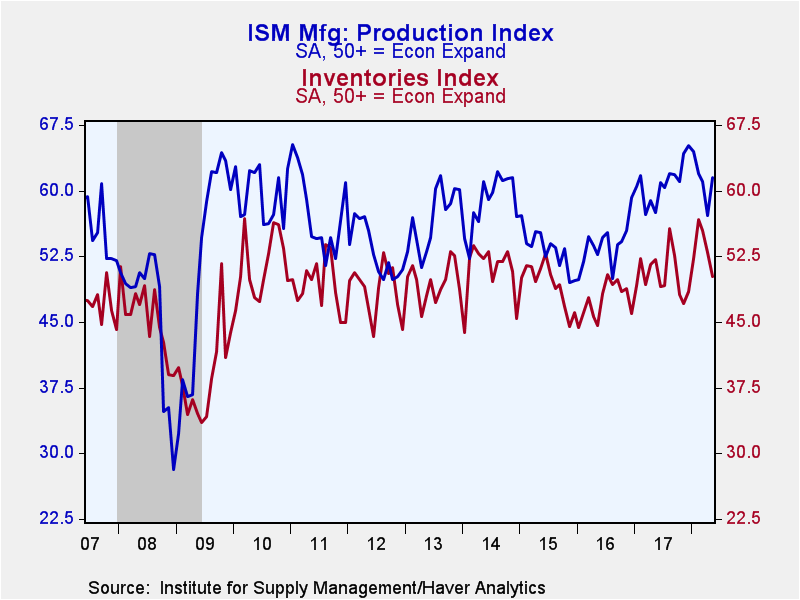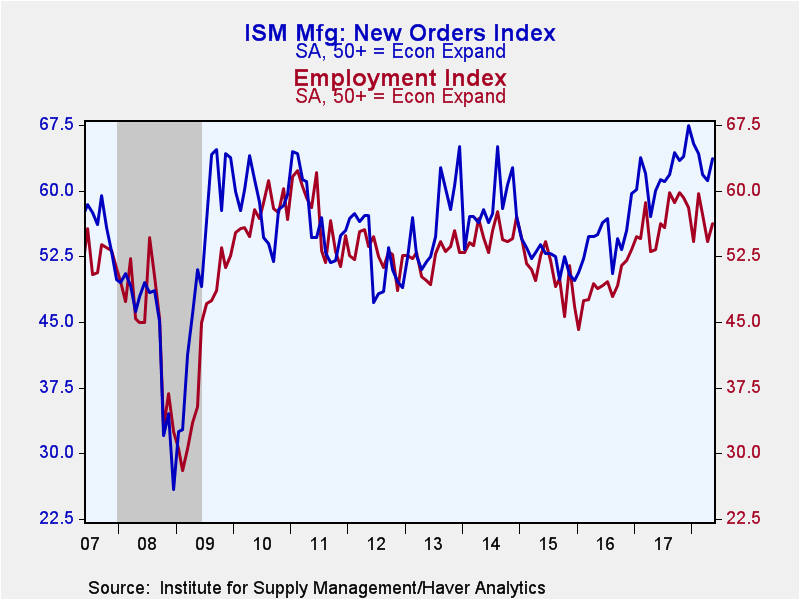 Global| Jun 01 2018
Global| Jun 01 2018ISM Factory Sector Index Rebounds in May
by:Sandy Batten
|in:Economy in Brief
Summary
Activity in the factory sector picked up in May following a moderation in April. The ISM headline manufacturing index jumped 1.4 points to 58.7 in May from 57.3 in April. This index has moderated since earlier this year, but remains [...]
Activity in the factory sector picked up in May following a moderation in April. The ISM headline manufacturing index jumped 1.4 points to 58.7 in May from 57.3 in April. This index has moderated since earlier this year, but remains elevated in historical terms. Readings over the past nine months have been among the highest since mid-2004. A level of 58.0 had been expected in the Action Economics Forecast Survey. During the last ten years, there has been a 76% correlation between the level of this index and q/q growth in real GDP. Indeed, the report from the ISM estimated that the May figure corresponds to a 4.8% annual rate increase in real GDP. This was the 21st consecutive month that this index exceeded the critical expansion-contraction level of 50.
The strength in the May report was widespread. Four of the five components of the headline index rose in May. Particularly strong were new orders and production. The new orders index jumped up 2.5 points to 63.7, its 13th consecutive monthly reading above 60. The production index surged 4.3 points to 61.5. It has been above 60 in 12 of the past 13 months. Supplier delivery times rose to 62.0, inventories fell and order backlogs rose in May (to its highest level since April 2004), indicating that manufacturers are having more difficulty keeping up with demand. Of the 18 industries in the survey, 16 reported growth in May, while 2 reported no change from April. None reported declines. In keeping with the stronger-than-expected May employment report (released earlier today), the employment index rebounded to 56.3 in May.
The prices paid index (NSA) edged up to an elevated 79.5 in May (its highest reading since April 2011) from 79.3 in April, indicating that most producers are experiencing increases in raw materials prices. However, note that oil prices are currently rising and all producers use energy. Historically, this index has risen to elevated levels during periods of rising oil prices.
Among the other series measured by the ISM, the export order index continued to decline, falling to 55.6, its third consecutive monthly fall. The import order index also experienced its third consecutive monthly decline, falling to 54.1 in May.
The ISM figures are diffusion indexes where a reading above 50 indicates expansion. The figures from the Institute for Supply Management can be found in Haver's USECON database. The expectations number is available in Haver's AS1REPNA database.
| ISM Mfg (SA) | May | Apr | Mar | May'17 | 2017 | 2016 | 2015 |
|---|---|---|---|---|---|---|---|
| Headline Index | 58.7 | 57.3 | 59.3 | 55.5 | 57.4 | 51.4 | 51.3 |
| New Orders | 63.7 | 61.2 | 61.9 | 60.0 | 62.2 | 54.5 | 52.3 |
| Production | 61.5 | 57.2 | 61.0 | 57.5 | 61.0 | 53.8 | 59.3 |
| Employment | 56.3 | 54.2 | 57.3 | 53.3 | 56.8 | 49.2 | 50.7 |
| Supplier Deliveries | 62.0 | 61.1 | 60.6 | 54.4 | 56.8 | 51.8 | 50.8 |
| Inventories | 50.2 | 52.9 | 55.5 | 52.1 | 50.4 | 47.5 | 49.4 |
| Prices Paid Index (NSA) | 79.5 | 79.3 | 78.1 | 59.5 | 65.0 | 53.1 | 40.1 |
Sandy Batten
AuthorMore in Author Profile »Sandy Batten has more than 30 years of experience analyzing industrial economies and financial markets and a wide range of experience across the financial services sector, government, and academia. Before joining Haver Analytics, Sandy was a Vice President and Senior Economist at Citibank; Senior Credit Market Analyst at CDC Investment Management, Managing Director at Bear Stearns, and Executive Director at JPMorgan. In 2008, Sandy was named the most accurate US forecaster by the National Association for Business Economics. He is a member of the New York Forecasters Club, NABE, and the American Economic Association. Prior to his time in the financial services sector, Sandy was a Research Officer at the Federal Reserve Bank of St. Louis, Senior Staff Economist on the President’s Council of Economic Advisors, Deputy Assistant Secretary for Economic Policy at the US Treasury, and Economist at the International Monetary Fund. Sandy has taught economics at St. Louis University, Denison University, and Muskingun College. He has published numerous peer-reviewed articles in a wide range of academic publications. He has a B.A. in economics from the University of Richmond and a M.A. and Ph.D. in economics from The Ohio State University.










